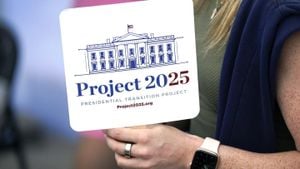With the shifting tides of American politics, climate policy is poised for significant transformation under the presidential watch of Donald Trump, as he prepares to take office for his second term. Following substantial Democratic efforts to combat climate change and promote emission-free energy through the Inflation Reduction Act (IRA), Trump and his Republican allies are gearing up to make their mark by modifying the very frameworks established by the previous administration.
Trump, now slotting back as President-Elect, finds himself, again, at the helm of changing America’s stance on climate issues, which he has previously criticized as “the green new scam.” This bold statement underlines his intent to attack what he perceives as excessive government expenditure and misguided climate initiatives. While there’s no expectation of outright repeals, significant changes are certainly on the table.
According to James Lucier, managing director at Capital Alpha Partners, there's no rush to implement extreme changes overnight. Instead, modifications to the IRA could gradually trickle through, possibly capping or phasing out certain provisions as Trump settles back to power. The IRA has merged climate policy with broader industrial needs, subsidizing various sectors like electric vehicles and solar energy, all pivotal for the decarbonization goal.
Interestingly, the response from some Republican lawmakers is not as uniformly anti-IRA as one might expect. Several GOP legislators, particularly those from traditionally red districts, are acknowledging the benefits reaped from the investments under the IRA. They remain hesitant to let go of incentives like credits for producing hydrogen or capturing carbon dioxide, which have gained traction among key party constituencies, including oil companies.
Gina McCarthy, who previously served as White House climate adviser, voices her concerns over Trump’s potential moves. She named Trump's anticipated rollback efforts as “a fool’s agenda,” highlighting how congressional Republicans have been actively participating in ribbon-cutting ceremonies for IRA-supported projects, thereby expressing their vested interest.
Despite this cautious support for existing programs among some Republicans, Trump’s administration is expected to enforce tighter controls on many of these initiatives, leveraging them as fiscal tools to offset other priorities like extending tax cuts initiated during his first term. Scott Bessent, who may be appointed as potential Treasury Secretary, articulated the party's priorities sharply, calling the IRA “the doomsday machine for the budget.” With such stark opposition, it's apparent Trump's strategies will involve reining back IRA's far-reaching impacts.
Speculation arises around which components of the IRA might face the axe. Observers have noted key targets, such as the credits related to used and commercial electric vehicles, the levies on methane emissions for certain fossil fuel producers, and various financial powers allocated to the Energy Department for loan programs. These adjustments might accompany stronger sourcing restrictions for materials used across the board, implicatively narrowing down tax credit eligibility for American and foreign entities alike.
Adding another layer of complexity, operational changes could take place without direct congressional involvement. The Treasury Department holds potential authority to reshape guidelines to suit the new governance style, possibly imposing stricter rules on tax credit qualifications. Critiques have flagged the lax criteria for leased EVs, known derisively as the “leasing loophole,” likely facing elimination under this new eye of scrutiny.
Republicans also appear eager to dismantle the credits tied to technology-neutral clean electricity generation, which are scheduled to commence next year. These incentives target the sustainability of electricity generation from renewable sources, namely solar and wind. The timeline for their termination could stretch well beyond the early 2030s if the U.S. electricity sector fails to slash carbon dioxide emissions by nearly 75% relative to 2022 levels, hardly optimistic according to energy analysts.
Ryan Sweezey from Wood Mackenzie Limited sums it aptly: “We are talking decades, and definitely trillions of dollars.” This dire forecast is reflective of the steep challenges the U.S. will face as it tries to navigate this complex terrain of energy transitions alongside political ideologies.
Simultaneously, as Trump readies to assume power, the outlook for voluntary carbon markets (VCMs) also seems tenuous. Anna Karakitsos, senior government affairs advisor at Bracewell, highlights how VCMs operate as platforms where various stakeholders can voluntarily purchase carbon credits to mitigate their emissions. Unlike rigid compliance markets, they empower companies to act independently, funding multiple environmental initiatives.
Nevertheless, Karakitsos points out the nascent carbon markets are grappling with their set of challenges—primarily the need for stringent standards preventing double counting and ensuring meaningful carbon reductions. While the Biden administration made strides to bolster these markets, the entry of Trump's administration might usher skepticism and stifling regulatory environments, potentially hampering progress.
Under Trump’s reign, the future of VCMs could see systemic changes; the conversation may shift heavily toward regulation if past patterns are observed. There’s considerable apprehension about whether the abrupt pivots will discourage corporate participation amid uncertainties over market stability.
Reflecting on the potential repercussions of Trump succeeding at the White House once more, the delicate balance of American climate policy hangs precariously in the balance. Whether every expressed intent translates to tangible outcomes remains to be seen, especially when intertwined with Republican strategies both at the executive and legislative levels.
Moving forward, not only will the effectiveness of Trump's actions under his incoming term inform climate discussion, but they will also significantly influence the direction of investment within the clean energy sector, providing ripples downstream to environmental outcomes across state lines. While many of the pieces of legislation laid by the previous administration remain ripe for cuts, the embrace of some incentives by Republican lawmakers emphasizes the political tug of war at play, with many vying to benefit from a piqued green economy.
The broader thematic narrative of climate governance under Trump's return depicts compelling contrasts between ideologies and operational realities, reflecting historical patterns of resistance and change. The skepticism toward climate initiatives from the past to today, coupled with the rise of disruptive technologies, will loom large as the saga continues, beckoning stakeholders worldwide to keep their eyes peeled for the next pivotal developments. The collision of expectations and real-world impacts is bound to shape not just the local narrative of energy production but significantly impact how the U.S. is perceived on the global stage concerning its commitments toward addressing climate change.



